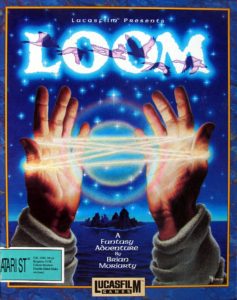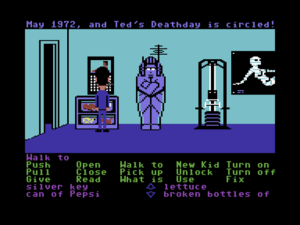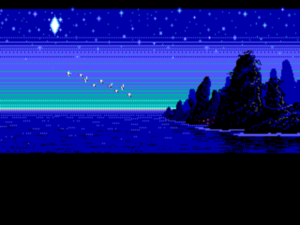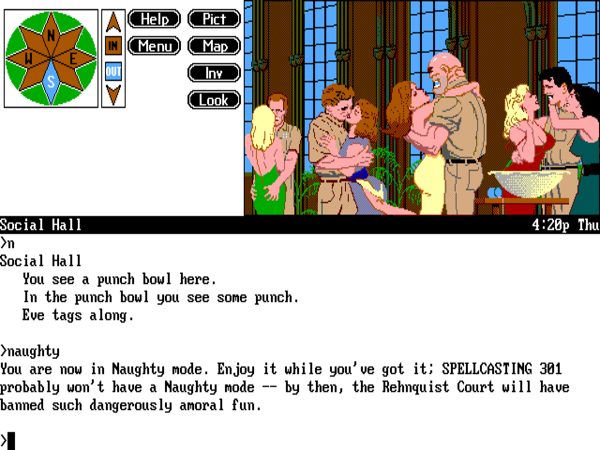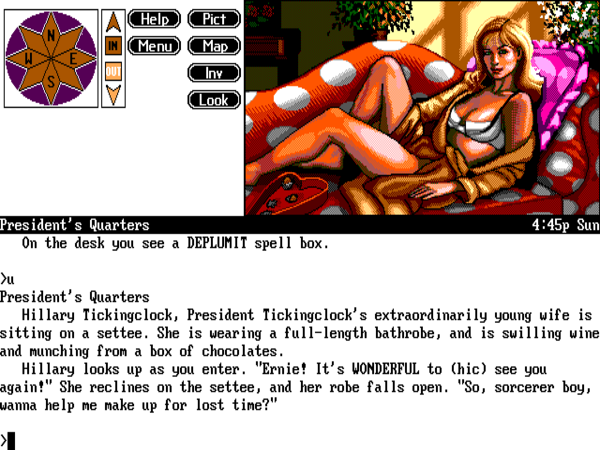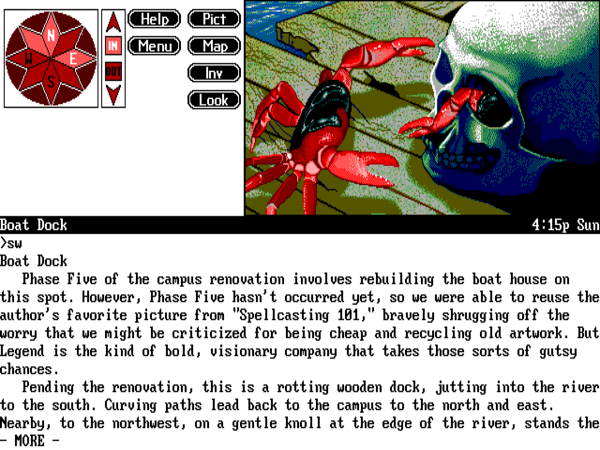
A quarter of a century after Ted Nelson first coined the term, hypertext finally stepped into the spotlight in 1987. As we’ve seen in an earlier article, the primary driver of its long-delayed public recognition was Apple’s HyperCard, which in the wake of its premier at the MacWorld show in August went on to become the product of the year in the eyes of most industry pundits. But concurrent with the HyperCard hype were a number of other, smaller developments — enough to convince one that hypertext’s newfound fame might be down to more than just the whim of a major corporation, that it might be in some more organic sense an idea whose time had simply come.
The American Association of Computing Machinery, the oldest and arguably the most respected learned society devoted to computing in the world, had decided to hold a conference on hypertext well before HyperCard was more than a Silicon Valley rumor. When the conference actually took place in November of 1987, however, it could only benefit from the HyperCard excitement, which gave it a sense of relevance that stuffy academic conferences all too often don’t manage to capture. While many things were discussed over the course of those few days, the conference would go down in history for the debut of Storyspace, the first tool explicitly designed for authoring hypertext narratives on a personal computer, and for that of afternoon, a story, the first work ever to label itself a “hypertext novel.” These twin debuts also mark the beginning of what would become known as the Eastgate school of self-described “serious” hypertext, one of the less accessible — in both the figurative and, today, the literal sense — movements in the history of digital narratives.
The co-creator of Storyspace and the author of afternoon was Michael Joyce, a professor of language and literature at Jackson Community College in Jackson, Michigan. Shortly after completing his first print novel in 1981, Joyce had bought his first computer, an Apple II, and immediately been captivated by what he saw as a whole new world of writing possibility. Responding to what he described as his frustration with the limitations of linear storytelling, he cultivated an eclectic web of friendships to pursue his interest in exploring new narrative structures enabled by computers. Most prominent among this group were Howard Becker, a sociologist at Northwestern University and fellow Apple enthusiast (he provided Joyce with a steady flow of pirated games, including many Infocom titles); Natalie Dehn, a researcher at Yale’s Artificial Intelligence Lab; and Jay David Bolter, a classicist at the University of North Carolina who was investigating generative storytelling on computers as a sideline. After upgrading to the new Apple Macintosh soon after its release, Joyce and Bolter, the latter of whom was a self-taught programmer, began working in earnest on Storyspace. From the beginning, Bolter took advantage of the Macintosh GUI to make the system accessible to non-programmers like Joyce. A snapshot of the work in progress from 1985:
The program currently represents structure as a map or network of rectangular cells and straight lines. Cells are units of text that may range in size from one character to 30,000. The author creates cells, labels them, positions them on the screen using the mouse, and attaches text. Stacking cells inside other cells indicates hierarchical relationships, while drawing and labeling lines from one to another indicates associative links. The author may then use the created structure to control or review the presentation of the text.
The pace of Storyspace development accelerated that same year when Joyce and Bolter won a grant from the Markle Foundation, allowing them to employ other programmers on the project.

The current Storyspace version 3 is not at all different conceptually from the system that Joyce and Bolter came up with in the 1980s. Nodes of text are represented as onscreen cells, to be connected together by the author using the mouse. The system is very accessible for non-programmers, but, because there is no real facility for tracking state, much less for modeling a world “behind” the surface text, it can also be very limiting. How much the character of the works created with Storyspace was down to ideology in the abstract and how much was down to ideology molding itself to the limitations of the technology is a little questionable.
In years to come, Michael Joyce and his fellow proponents of serious hypertext would seem willfully determined to disassociate themselves from existing commercial software — and especially from computer games. It’s interesting therefore to note that Joyce and Bolter’s original descriptions of Storyspace to potential funders didn’t describe it strictly as the tool for the academic avant garde that it would eventually become. The Markle Foundation funded Storyspace’s development based on a pitch that emphasized its applicability to business and to more mainstream, Choose Your Own Adventure-style branching narratives.
Still, someone had to be the first to make something in Storyspace. A new development system of any stripe can always benefit from a killer app to demonstrate its capabilities, and Storyspace was no exception, as Joyce’s friend Howard Becker pointed out to him: “One thing that will really help nerds like me see how to use this will be a couple of good examples, spelled out in real detail, and included on the disk. Like a story by you…” afternoon, a story, the most famous, most read, and most analyzed work of the Eastgate school, was thus created with the rather practical goal of simply showing off what Storyspace could do to potential investors and customers. Joyce began to write it in March of 1987, and had completed it in time to bring it to Chapel Hill, North Carolina, in November for the ACM hypertext conference, hosted by Jay David Bolter’s employer the University of North Carolina. Joyce and Bolter gave out copies of afternoon to conference attendees after their presentation on Storyspace. History hasn’t recorded in any detail the computer scientists’ reaction to Joyce’s daunting work of postmodern literature, but we’re on firmer ground on the subject of the authoring system he had used to create it: Storyspace became the hit of the conference.
Following that rapturous reception, Joyce and Bolter, joined now by a University of North Carolina computer scientist named John B. Smith, formed a company they named Riverrun and started pitching Storyspace to software publishers. They talked for some time with Brøderbund, who went so far as to lend them hardware and expertise to further the project after the Markle Foundation’s funding ran out. But in February of 1989 Brøderbund bowed out in response to, as historian Matthew Kirschenbaum puts it, “lingering confusion over exactly what the tool did and who its potential audience was.” Brøderbund was seemingly skeptical whether this group of academics was truly capable of creating a product that would appeal to the mainstream of Middle America, the commercial sweet spot Brøderbund was almost uniquely adept among their peers at reaching with products like The Print Shop and the Carmen Sandiego series.
Having been rejected by Brøderbund and the rest of the consumer-software industry, who were going through troubled times and growing ever more risk-averse thanks to the Nintendo onslaught, Joyce, Bolter, and Smith turned to Mark Bernstein, founder of a tiny company called Eastgate Systems dedicated to researching future applications of hypertext. In 1990, Eastgate published Storyspace at last, and also published afternoon, a story as their debut work of hypertext fiction. Both garnered modest interest in the mainstream press as curiosities and possible harbingers of the future. Indeed, Eastgate had big plans for the future. Occupying some hazy middle ground between software publisher and book publisher, they would for much of the 1990s publish multiple works of hypertext fiction and nonfiction each year alongside the Storyspace software that was used to create them. For a time they even published their own magazine, The Eastgate Quarterly Review of Hypertext, full of theory on the one hand and news about their latest products on the other, like a highbrow version of Infocom’s old New Zork Times. In 1992, Robert Coover, like Michael Joyce a print novelist turned hypertext evangelist, published an opinion piece in The New York Times that served as a manifesto of sorts for what the Eastgate school of writers believed would become a major — indeed, potentially revolutionary — literary movement. We’ll return to that a little later. But first, more on afternoon, a story itself and the works it spawned.
Authors of the Eastgate school, who were almost universally academics working in the humanities, saw themselves as pushing the literary novel to the next stage of its formal evolution. For this reason, many or most of their works have as much or more to do with explicating certain ways of thinking about literature and literary criticism as they do with plot, character, or any of the other attributes of traditional novels. Their works are steeped in the post-structuralist school of literary criticism, which is itself an outgrowth of the postmodern philosophy of thinkers like Jacques Derrida. While I do understand that an extended discussion of such topics probably won’t set your hearts aflutter with anticipation, I do think a little background is necessary to an understanding of what the Eastgate school was all about. So, please bear with me while I set the stage as painlessly as I can manage.
The road to the Eastgate school really does begin with Jacques Derrida, who from the 1960s until his death in 2004 remained the preeminent voice of postmodernism as it applied to literary criticism and many other endeavors. It was Derrida who invented the concept of deconstruction — a concept that, like many of the concepts associated with postmodern philosophy, seems virtually impossible to fully define. In writings that must stand as some of the most impenetrable ever committed to paper, Derrida himself did such a baffling, self-contradictory job of it that he’s often been accused of not knowing quite what it was himself, and of attempting to obscure that lack through sheer weight of verbiage. The problem was only complicated in later days by the mainstream media’s latching onto the term and using it constantly as little more than a synonym for “analyze.”
Still, if we stay safely at the shallow end of the pool, deconstruction can be a very straightforward, noncontroversial idea: the idea that one can learn much about a text by teasing out the unexamined assumptions of its author. Herman Wouk, to take an example, doubtless considered himself quite an enlightened man when he published The Caine Mutiny in 1951, but his condescending descriptions of the titular minesweeper’s black kitchen staff says much about the racist attitudes of his time. At this level, then, deconstruction implies little more than a skeptical reading between the author’s lines, and a willingness to seek context outside of the work itself.
At the deeper end of the pool, however, we come to the claims that nothing can ultimately mean anything at all. Derrida rejected the notion, underpinning in different ways both religion and science, that there is an absolute Truth out there somewhere which we can approach if not reach via earnest inquiry. In Derrida’s view, any absolute Truth must belong to the realm of metaphysics — a realm in which he refused to believe. Instead of Truth, he saw a multiplicity of individual, subjective “truths,” hierarchies of constructed meaning — thus meanings ripe for deconstruction — tied to hierarchies of social power. Deconstructionism has always walked hand in hand with Marxism and other radical political ideologies. Just as Marxism envisions an end to the privileges of authority, deconstructionist thought seeks an end to the privilege accorded to the author as the final authority on her work’s meaning.
At the risk of being accused of getting too cute or playing games of gotcha!, I can’t resist pointing out the logical contradiction inherent in the supposed objective Truth that there is no objective Truth. More seriously, though, the idea that all meaning is constructed and subjective is one that will doubtless continue to strike each incoming group of humanities undergraduates as a profound revelation, and to strike those of us who have been around it for a few years — those of us who haven’t become Derrida scholars, that is — as the most tedious of hobby horses to continue flogging. It seems to me that the problem with radical deconstructionism and, indeed, postmodernism in general is that it’s very hard to know what to really do with them. What’s the point of saying anything if you don’t believe it’s possible to say anything that bears any relationship to any Truth outside itself? Much rationalization has been done in an attempt to avoid the nihilism to which postmodernism would seem inevitably to lead, but the arguments have never struck me as terribly convincing.
Of course, any attempt to fully capture Truth in writing, whether on the grand scale of history or the empathetic scale of an individual character, must inevitably fail at some level, must run afoul of subjectivity and the limits of the author’s cognition and experience. This is a Truth that any competent writer or historian — and I do like to believe I manage to be both on a good day — must always keep in mind. Still, the point of the endeavor is the striving, the point is to come as close as you can to the ideal of a captured Truth. If you don’t believe there is anything out there to be striven for, why bother? The debate is not strictly an academic one. Taken to an extreme, a refusal to believe in the existence of verifiable facts is not just absurd but actively dangerous, as the current president of my country is so masterfully demonstrating as I write these words.
But now let’s turn our attention back to afternoon, a story, a work steeped in postmodern thought, to see what effect those patterns had on this work of literary hypertext.
I try to recall winter. < As if it were yesterday? > she says, but I do not signify one way or another.
By five the sun sets and the afternoon melt freezes again across the blacktop into crystal octopi and palms of ice — rivers and continents beset by fear, and we walk out to the car, the snow moaning beneath our boots and the oaks exploding in series along the fenceline on the horizon, the shrapnel settling like relics, the echoing thundering off the far ice.
<Poetry > she says, without emotion one way or another.
Do you want to hear about it?
And so, with this passage that could only have issued from an overwrought teenager or a tenured academic, we begin our “story” — a word, one has to assume, that Joyce means ironically, for replying that yes, we do want to hear about it, yields anything but a straightforward story. This is not an exercise in “What do you want to do next?” It’s rather a web of allusions and musings, with no foregrounded action at all. As near as I’ve been able to divine through much feverish clicking, our story, such as it is, is that of Peter, a man who has just witnessed a car crash that may have killed his ex-wife and his son. If we are persistent enough, we may eventually arrive at a node that seems to say that Peter himself may be responsible for their deaths in some way. But that’s the closest we can ever get to any sort of resolution; this alleged “story” of more than 500 nodes is not only nonlinear but endless, every node always looping back onto other nodes.

“A thin young man with a lavender penis and huge, swollen balls,” huh? Don’t threaten me with a good time!
In terms of interface, afternoon must strike us today as a strange beast, and it’s a little hard to determine how much of that strangeness is down to conscious intent and how much is down to the era when it was first created, well before our modern expectations for a hypertext interface had been set in stone. Those sections of the text which lead to other sections — in Joyce’s preferred parlance, those “words that yield” — are not highlighted in any way. Indeed, in later editions of afternoon every word in the text will lead you somewhere else, albeit all too often to one of the same set of uninteresting cul de sacs. There is at least a back button for when you get caught in one of these, along with a forward button that will yield a default next node if you don’t wish to choose one — but, typically for this work that seems so self-consciously designed to stymie and frustrate its reader, traversing the entire text using the default option only winds you up in one of those uninteresting cul de sacs. And then there are also “yes” and “no” buttons, which you can use to respond to occasional explicit questions or just click for the hell of it at any time to go somewhere else. Given that afternoon consists of more than 500 nodes, and that the relationships between them all are intuitive at best, random at worst — certainly anything but logical — trying to get a sense of it all is a fairly monumental endeavor.
But people have certainly tried, and therein lies a noteworthy tension between what afternoon believes itself to be and what it actually is. Michael Joyce and many others of the Eastgate school were always determined to disassociate their work from games, even “literary” games like those of Infocom. Yet to say that afternoon isn’t a game in the same sense that Infocom’s interactive fictions are games goes against the way that almost everyone responds to it. (Whether adventure “games” and similar interactive works really are games in the same sense that competitive zero-sum exercises are games is a separate discussion which we’ll have to leave unaddressed today.) Confronted with this word salad, we want to figure it out, to make sense of it, to find out what the hell Peter is on about. Thus there is a puzzle to be unraveled here, an implicit ludic challenge to be confronted. Even much of the academic writing on afternoon obsesses over this process of figuring it out. In this sense, then, afternoon is not so far from an Infocom game — or for that matter a mystery novel — as Joyce might prefer to believe. Whether it constitutes a good game or puzzle is of course another question entirely.
And on that subject, I have to be honest: afternoon, a story bores the living daylights out of me. If it was interested in empathetically exploring the feelings of Peter, it might have been a moving work. If it was interested in letting the reader get to the definitive bottom of what really happened to Peter’s ex-wife and son, it might have been an intriguing one. If it could have shown even a flash from time to time of self-awareness or humor instead of remaining so relentlessly, pretentiously po-faced, it might at least have been a little more likeable. But, sadly in my view, Michael Joyce isn’t interested in doing any of these things. What Joyce is interested in is, in the words of critic Janet Murray, “intentionally ‘problematizing’ our expectations of storytelling, challenging us to construct our own text from the fragments he has provided.” Yet the text he has provided is so leaden and dull that the only type of interest such an exercise can muster is theoretical interest in the mind of a post-structuralist literary critic. I find this sort of self-reflexive art — art about nothing more than the process of its own creation, or the process of its own reception — to be a betrayal of art’s potential to move and change us. “Problematizing our expectations of storytelling” is a thin foundation on which to build a work of deathless literature.
So, we return now to that zeitgeist-capturing New York Times piece of 1992, written by Robert Coover, who would go on to become something of an elder statesman for the Eastgate school. It was entitled “The End of Books.” Like so many zeitgeist-capturing pieces, it comes across as almost hilariously dated today, but nevertheless remains the logical next stop for anyone trying to understand what the Eastgate school was all about. First, the article’s opening. Afterward, in the spirit of turnabout being fair play, we shall indulge in a little of what some might refer to as deconstruction of our own.
In the real world nowadays, that is to say, in the world of video transmissions, cellular phones, fax machines, computer networks, and in particular out in the humming digitalized precincts of avant-garde computer hackers, cyberpunks and hyperspace freaks, you will often hear it said that the print medium is a doomed and outdated technology, a mere curiosity of bygone days destined soon to be consigned forever to those dusty unattended museums we now call libraries. Indeed, the very proliferation of books and other print-based media, so prevalent in this forest-harvesting, paper-wasting age, is held to be a sign of its feverish moribundity, the last futile gasp of a once vital form before it finally passes away forever, dead as God.
Which would mean of course that the novel, too, as we know it, has to come to its end. Not that those announcing its demise are grieving. For all its passing charm, the traditional novel, which took center stage at the same time that industrial mercantile democracies arose — and which Hegel called “the epic of the middle-class world” — is perceived by its would-be executioners as the virulent carrier of the patriarchal, colonial, canonical, proprietary, hierarchical and authoritarian values of a past that is no longer with us.
Much of the novel’s alleged power is embedded in the line, that compulsory author-directed movement from the beginning of a sentence to its period, from the top of the page to the bottom, from the first page to the last. Of course, through print’s long history, there have been countless strategies to counter the line’s power, from marginalia and footnotes to the creative innovations of novelists like Laurence Sterne, James Joyce, Raymond Queneau, Julio Cortazar, Italo Calvino and Milorad Pavic, not to exclude the form’s father, Cervantes himself. But true freedom from the tyranny of the line is perceived as only really possible now at last with the advent of hypertext, written and read on the computer, where the line in fact does not exist unless one invents and implants it in the text.
“Hypertext” is not a system but a generic term, coined a quarter of a century ago by a computer populist named Ted Nelson to describe the writing done in the nonlinear or nonsequential space made possible by the computer. Moreover, unlike print text, hypertext provides multiple paths between text segments, now often called “lexias” in a borrowing from the pre-hypertextual but prescient Roland Barthes. With its webs of linked lexias, its networks of alternate routes (as opposed to print’s fixed unidirectional page-turning) hypertext presents a radically divergent technology, interactive and polyvocal, favoring a plurality of discourses over definitive utterance and freeing the reader from domination by the author. Hypertext reader and writer are said to become co-learners or co-writers, as it were, fellow travelers in the mapping and remapping of textual (and visual, kinetic and aural) components, not all of which are provided by what used to be called the author.
Coover comes across like a caricature of the pretentious academic with his name-dropping irrelevant asides to demonstrate his erudition (“what Hegel called ‘the epic of the middle-class world'”) and his painful attempts to capture the spirit of William Gibson (“the humming digitalized precincts of avant-garde computer hackers”). The language of deconstruction and post-structuralism is everywhere. The conventional reader is forever being “dominated” and “tyrannized” by the “patriarchal,” “colonial,” “canonical,” “proprietary,” “hierarchical,” “authoritarian” author. But, even setting the loaded language aside, is she really so much under the author’s thumb? It seems to me that the reader always has the ultimate veto power over the author in the form of the ability to put the book down and not read it anymore. If she chooses to continue, to follow the line to the end, she is doing so willingly, and can hardly be considered a subjugated victim.
Further, is the “tyranny of the line” truly a tyranny? Far from being compelled to follow the author “from the first page to the last,” the reader is always free to skip around in a text, to read the parts that interest her in the order she prefers. Why else do tables of contents and indexes exist? Those of us who made it through a graduate program in the humanities were all forced by the sheer amount of reading that is assigned to learn how to delicately but mercilessly fillet a book in order to extract exactly what we need from it in the minimum length of time. Far from being subjected to the author’s tyranny, we learned to rip the beating heart out of the author’s little darling and dissect it on our desktops. It’s a skill that still serves me well in the work I do today, as the bloody remains of this article’s list of sources lying strewn around me right now will attest.
And then is the best way to achieve a “plurality of discourses” really to try to stuff them all into a single nonlinear book? Wouldn’t it perhaps make more sense to just, you know, read several books?
But most problematic of all is the article’s core premise/prophecy: that hypertext will lead to the “end of books.” The end of print, Coover tells us, will “of course mean that the novel, too, as we know it, has to come to its end.” In reality, there’s no “of course” about this proposition at all. Coover demonstrates a colossal failure of imagination in conflating the literary form of the novel with print, the physical medium on which novels were almost exclusively delivered in 1992. As the thriving modern ebook market demonstrates, the medium is not necessarily the message in this case. Let’s give him the benefit of the doubt, though, and look past even this confusion. As long as we’re talking about tyranny, we should note that Coover’s essay never asks what real-world readers actually want. Do they really wish to become “co-learners” and “co-writers”? I think most would reply that writing is what they’re paying the author to do, and that the author had damn well better learn her subject on her own time, before she starts trying to sell them a book about it.
Which isn’t to say that there isn’t room for interactive texts, and now more so than ever. As many readers of this blog are doubtless aware, choice-based stories like those published by Choice Of Games have achieved a certain degree of commercial success as the heirs to the Choose Your Own Adventure gamebooks of yore, while more poetic hypertext explorations created with tools like Twine reach their own audience of readers. Granted, the audiences for both styles of work remain by all indications fairly small, but they nevertheless dwarf the numbers that have ever read the literary hypertexts of the Eastgate school. So, while we are far, far from any end of books — and thank God for that! — there obviously is a readership for hypertext fiction, one that may even grow considerably in the future. The fact that the works which people are reading are so divorced from the works of the Eastgate school has everything to do with the failure of said school to write hypertext novels that people want to read. Summing up the heyday of the Eastgate school, scholar Adam Hammond says that “the most enduring legacy of this period is theoretical rather than creative.” It’s not really meant as a criticism of the works themselves, yet it’s hard for me to think of a better one.
Writing about the status of serious hypertext as of 2016, Hammond notes that it “is one of the few digital literary forms that can be plausibly regarded as dead”: “The works that seemed so revolutionary and world-altering were not only seldom read in their own time, but are today literally unreadable, languishing in antiquated software and hardware formats inaccessible to the contemporary reader.” Eastgate soldiers on somehow, still selling Storyspace — in fact, a new version was recently released — alongside a collection of hypertext novels that virtually all date from those halcyon days of the 1990s. Yet it’s hard to figure out to whom they could be selling this stuff as of 2017. They’ve done, as Hammond says, an horrendous job of keeping up to date with the changing times. I recently bought three hypertext novels from Eastgate: afternoon, a story, King of Space, and Victory Garden. The first of this group is the most famous work ever published by Eastgate, while the last is among the two or three next most famous. And yet none of them will Just Work on a modern computer. afternoon, a story comes the closest: it comes on a USB stick that will work on Mac OS X — but only on versions released prior to 2011. Victory Garden, meanwhile, won’t run on a 64-bit operating system of any stripe, while King of Space requires, incredibly, a version of Mac OS prior to OS X. (“1 M of memory and hard disk required,” announces the packaging.) I’m a fairly technical guy, and thus can get all this stuff running, but how many other prospective readers can make the same claim? When I placed my order, I was greeted with emails explaining the situation and asking if I really wanted to pay all this money for these relics, which Eastgate still sells for $25 or more apiece. There then followed more elementary questions about delivery methods and the like. Everyone was very nice, but I couldn’t help myself from conjuring a scene that ought to be a Saturday Night Live skit if it isn’t one already, taking place in a disused office space somewhere inhabited by a couple of dozing employees: “Hey, wake up! We actually have a customer!”
As should be obvious by now, I have little truck with most of what I’ve seen of the Eastgate school. I’m always skeptical of writers who make a point of telling me they are writing “serious” works, for it always leads me to think about the greatest writer I’ve ever read, William Shakespeare, who never laid claim to being more than a working playwright feeding the public’s appetite for new entertainments. Writers in my opinion should simply write, and leave the judgments to the critics and, most of all, to history. Given this bias of mine as well as all of the other problematic (to me) rhetoric surrounding the Eastgate school, and given that it so conspicuously failed to set the world on fire as promised in Coover’s article, you might well be asking why I’ve bothered to write all these words about its origins. It’s a fair question, and one to which I will, if you’ll bear with me just a little longer, give three answers.
The first answer is that there is some real historical interest here in the context of more contemporary choice-based narratives. Storyspace was the first of its kind, the urtext of systems like Twine and the Choice Of Games engine. While it has generally been used to create works of a very different character than those more recent systems, there is no reason why it couldn’t create, say, a contemporary take on Choose Your Own Adventure full of concrete choices — “I want to go here and do that!” — instead of more abstracted explorations of a writerly space.
The second answer is that the movement simply deserves an evaluation — or an obituary if you must — from someone outside its orbit. I may very well not be the person who is best-qualified to provide that evaluation, but for right now anyway I’m all it’s got.
But it’s the third answer that may be the real answer. This blog has always been, among other things, a chronicle of my personal journey through the history of interactive entertainment. And the fact is that, while I’ve seen the big flagship works and not been overly impressed, much of what languishes in the Eastgate catalog is completely unknown to me, and much of it sounds rather intriguing despite that whisper from my worse if wiser self that tells me I’m probably in for more disappointment. I wonder for instance about the aforementioned King of Space, a hypertext novel I’ve purchased but haven’t yet tried; in addition to what certainly reads like an extant and even intriguing plot, it contains, Eastgate tells us sotto voce, “elements of gaming.” (Shhh!) So, I do plan to dig into this and other Eastgate hypertext novels, to find out whether there are hidden away in their catalog works with some real meat on their bones and life flowing through their veins. I’ll continue to explore, and if I find that to be the case I’ll report back here. If not, this may well be my one and only article on the subject — mission accomplished, duty to history satisfied. We shall see.
In the meanwhile, how about we talk about an adventure game next time? Sound good to you? Well, at this point it sounds pretty good to me too.
(Sources: Literature in the Digital Age: An Introduction by Adam Hammond; Mechanisms: New Media and the Forensic Imagination by Matthew G. Kirschenbaum; “Postmodernism and Science Fiction” by Andrew M. Butler, from The Cambridge Companion to Science Fiction; Narrative as Virtual Reality and Avatars of Story by Marie-Laure Ryan; Cybertext: Perspectives on Ergodic Literature by Espen J. Aarseth; Hamlet on the Holodeck: The Future of Narrative in Cyberspace by Janet H. Murray; The New York Times of June 21, 1992.)
